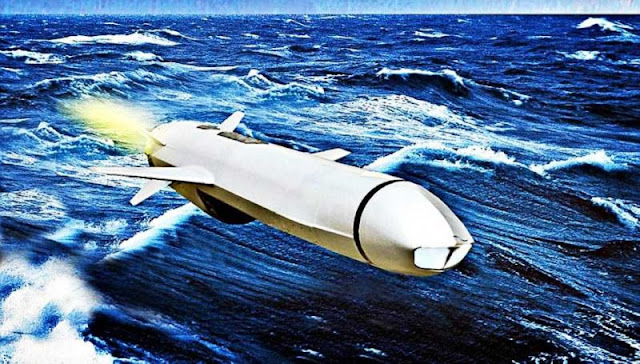A Buyers Market For Anti-Ship Missiles
June 26, 2013: There was recently a SINKEX (sinking exercise) in which Norway fired one of their locally made Naval Strike Missiles (NSM) at a decommissioned 2,100 ton Oslo class frigate. The NSM, fired from a smaller missile boat, hit the frigate, did a lot of damage but did not sink it. If the frigate had been loaded with fuel and ammo, the NSM would have started fires and probably put the ship out of service and possibly caused it to go down.
Despite the many lightweight (under a ton) anti-ship missiles on the market, NSM still gets sales because it is effective, reliable and affordable. It is also offered for use on ships, aircraft and on trucks (as part of a mobile coastal defense system). The 409 kg (900 pound) NSM anti-ship missile has a 125 kg (275 pound) warhead and a range of 185 kilometers. NSM uses GPS and inertial guidance systems, as well as a heat imaging system (and a database of likely targets) for picking out and hitting the intended ship. Norwegian manufacturer Kongsberg allows buyers to easily install their own radar and control systems.
There is lots of competition, the main ones being the U.S. Harpoon and similar missiles from Russia and China. The Russian Kh-35 anti-ship missile is similar to the American Harpoon but lighter (610 kg/1,340 pounds, compared to 728 kg/1,600) and has less range (130 kilometers compared to 224 for the latest version of Harpoon). The Kh-35 (also known as the SS-N-25 or Switchblade) can be fired from helicopters, aircraft, ships, or shore batteries.
China sells a lot of C-801 and C-802 anti-ship missiles. The C-801 is 5.81 meters (18 feet) long, 360mm in diameter, has a max range of 42 kilometers and weighs 636 kg (1,400 pounds) each. The C-801 is similar to the French Exocet, and is believed to have been based on that missile.
The C802A is a 6.8m (21 foot) long, 360mm diameter, 682kg (1,500 pound) missile, with a 165kg (360 pound) warhead. The C802 has a max range of 120 kilometers, and moves along at about 250 meters a second. The French Exocet missile is the same size and performance, but costs twice as much (over a million dollars each, but the manufacturer is known to be flexible on pricing.)
The new Exocet MM Block 3 has twice the range (180 kilometers) because of their turbojet engine. This is a 670 kg (1,500 pound) missile that has been around for over three decades, has been proven in combat and is known to be reliable. The C802 is known to be less capable than the Exocet, but it looks similar.
Russia pioneered the use of larger (up to three ton) supersonic “carrier killer” anti-ship missiles. The most common example is the Yakhont which is an 8.9 meter (27.6 foot) long, three ton missile with a 300 kg (660 pound) warhead. Russia has been building missiles like this since the 1970s but they are only popular with the few nations that have a need to destroy American aircraft carriers.
Strategy Page
Despite the many lightweight (under a ton) anti-ship missiles on the market, NSM still gets sales because it is effective, reliable and affordable. It is also offered for use on ships, aircraft and on trucks (as part of a mobile coastal defense system). The 409 kg (900 pound) NSM anti-ship missile has a 125 kg (275 pound) warhead and a range of 185 kilometers. NSM uses GPS and inertial guidance systems, as well as a heat imaging system (and a database of likely targets) for picking out and hitting the intended ship. Norwegian manufacturer Kongsberg allows buyers to easily install their own radar and control systems.
There is lots of competition, the main ones being the U.S. Harpoon and similar missiles from Russia and China. The Russian Kh-35 anti-ship missile is similar to the American Harpoon but lighter (610 kg/1,340 pounds, compared to 728 kg/1,600) and has less range (130 kilometers compared to 224 for the latest version of Harpoon). The Kh-35 (also known as the SS-N-25 or Switchblade) can be fired from helicopters, aircraft, ships, or shore batteries.
China sells a lot of C-801 and C-802 anti-ship missiles. The C-801 is 5.81 meters (18 feet) long, 360mm in diameter, has a max range of 42 kilometers and weighs 636 kg (1,400 pounds) each. The C-801 is similar to the French Exocet, and is believed to have been based on that missile.
The C802A is a 6.8m (21 foot) long, 360mm diameter, 682kg (1,500 pound) missile, with a 165kg (360 pound) warhead. The C802 has a max range of 120 kilometers, and moves along at about 250 meters a second. The French Exocet missile is the same size and performance, but costs twice as much (over a million dollars each, but the manufacturer is known to be flexible on pricing.)
The new Exocet MM Block 3 has twice the range (180 kilometers) because of their turbojet engine. This is a 670 kg (1,500 pound) missile that has been around for over three decades, has been proven in combat and is known to be reliable. The C802 is known to be less capable than the Exocet, but it looks similar.
Russia pioneered the use of larger (up to three ton) supersonic “carrier killer” anti-ship missiles. The most common example is the Yakhont which is an 8.9 meter (27.6 foot) long, three ton missile with a 300 kg (660 pound) warhead. Russia has been building missiles like this since the 1970s but they are only popular with the few nations that have a need to destroy American aircraft carriers.
Strategy Page

Comments
Post a Comment